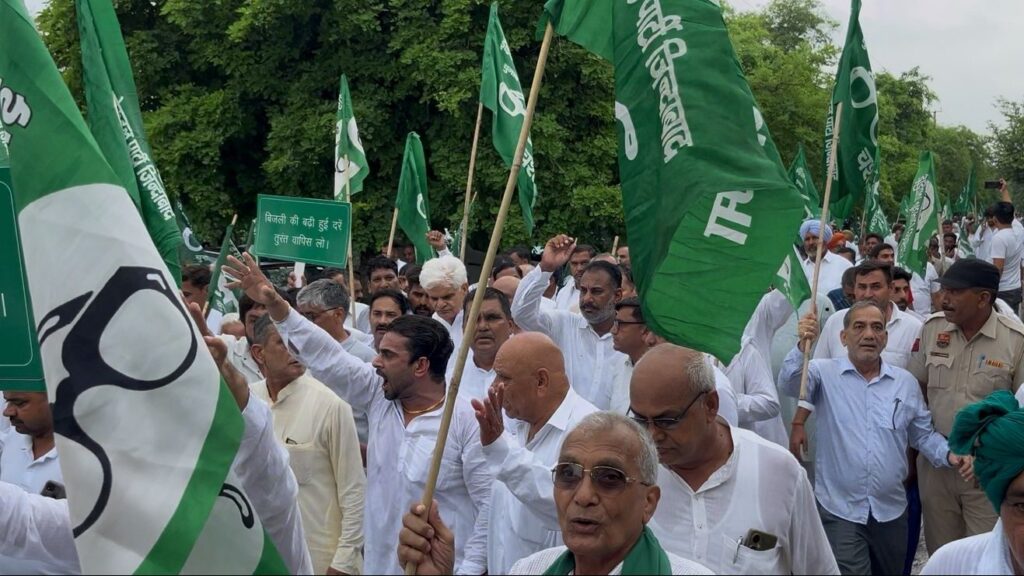ChandigarhJul 2, 2025 18:10 IST
First published on: Jul 2, 2025 at 18:10 IST
Three months after the Haryana Electricity Regulatory Commission (HERC) announced a tariff hike for domestic consumers, the issue has become a major rallying point for the Opposition.
As revised electricity bills began reaching households in the second and third weeks of June, former Chief Minister and senior Congress leader Bhupinder Singh Hooda alleged a four-fold increase in electricity charges. On Tuesday, senior Indian National Lok Dal (INLD) leader Abhay Singh Chautala led a protest outside the power utilities’ headquarters, Shakti Bhawan, in Panchkula to protest against the hike, the first in seven years.
While the Nayab Singh Saini government insists the tariff revision won’t affect most domestic consumers, the Opposition has seized on the issue, citing the sheer number of electricity users. Haryana has 84 lakh electricity consumers, 43.57 lakh served by Dakshin Haryana Bijli Vitran Nigam and 37.39 lakh by the Uttar Haryana Bijli Vitran Nigam.
Explaining the Opposition’s concerns, Hooda said, “Common families who earlier paid Rs 900 to Rs 1,000 are now receiving bills of Rs 4,000 to Rs 5,000. Power utilities have added a fixed charge of Rs 75 per kilowatt (kW), meaning a 10-kW connection now incurs an additional Rs 750 per month. Previously, rates were slab-based, ranging from Rs 2.5 to Rs 6.3 per unit for 50 units or more. Now, for loads above 5kW, the rate is Rs 6.5 to Rs 7.5 per unit.” He also noted that slab-wise rates have increased by 20 paise to 40 paise per unit.
State Energy Minister Anil Vij dismissed the claim of a four-fold hike as “entirely baseless and false.” He emphasised that agricultural tariffs remain unchanged: 10 paise per unit (metered) and Rs 15 per brake horsepower (for motors) per month at a flat rate. He added that monthly bills for domestic consumers with up to 2-kW connections had decreased by 49% to 75% compared to the 2014-15 financial year, and that most Category II consumers (up to 5kW load) had also seen reductions.
According to Vij, 94% of consumers fall under Category I (up to 2-kW load and monthly consumption up to 100 units) and Category II, and most of their bills have gone down. He also highlighted that the minimum monthly charges had been removed for all domestic categories.
At the Panchkula protest on Tuesday, the INLD accused the BJP government of reneging on its pre-election promise of providing up to 300 units of electricity free of cost.
The government, on its part, pointed out that this was the first tariff revision since 2018, despite rising power procurement and operational costs. “We managed to keep tariffs stable for nearly a decade through improved efficiency and strict financial discipline. From 2014-15 to 2024-25, aggregate technical and commercial (AT&C) losses, which refer to the total losses in an electricity distribution system, have been reduced from 29% to 10%,” it said in a statement.
Amid the growing political heat, former electricity minister and Congress leader Sampat Singh filed a review petition before the HERC, demanding a public hearing. “The surprising aspect of this electricity tariff order is that power companies are purchasing 7,964.28 crore units of electricity from various power generation units at Rs 3.12 per unit, and selling it to consumers at Rs 7.29 per unit. Moreover, only 6,916 crore units out of the total purchased are being delivered to consumers. With over 22% loss in transmission, consumers are effectively paying for energy they never received,” he said.




